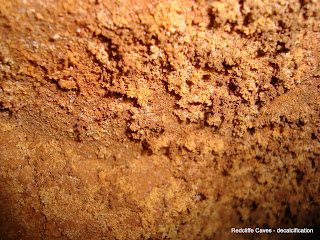The School of Earth Sciences at the
University of Bristol holds a collection of over 100,000 mineralogical, paleaontological
and petrological specimens which were donated to the School over the past 100
years. Some iconic specimens are an original map by William Smith, a near
complete and mounted skeleton of a sabre-toothed cat, fossilised bones of early
dinosaurs and an array of minerals from now inaccessible mines in the UK. The collection
also contains over 1500 type fossils and published specimens, a unique and
valuable resource to researchers worldwide.
 |
| Rhodochrosite from Argentina (BRSUG B2502) |
Over the past decade efforts have
been made to record and document the collection to unlock its scientific and
educational potential. The current digitisation project OnLine aims to improve
remote access to the wealth of geological specimens in the collection. The
project includes the design of a brand new website as well as the development of
an extensive photo archive and a searchable online database.
 |
| A taster of the future website of the Geology Collection University of Bristol, going live in autumn 2012. |
Claudia Hildebrandt, Collections
Manager: "With the valuable help of students and volunteers we have now
digitise over 60,000 specimen records for online publication. We collected
details from registers, card catalogues, collectors’ field notebooks and the
specimens themselves and merged all information into a comprehensive database. Additional
funding from JISC (as part of the BRICOLAGE project) allowed us to employ a student who reorganised
taxonomic, stratigraphic and geographic entries and ensured consistency across
the whole database.”
“We have also started to add recently
taken photographs of specimens to the database. This will offer users a look
behind the scenes of our stores.”
 |
| Volunteer Charlie Navarro editing photographs of Cretaceous chalk fossils. |
Once the website goes live in autumn
2012 the OnLine project will enter its second phase.
Claudia: “We aim to create links between
specimens and relevant scientific publications and publish a tool that
visualises the geographic distribution of all our UK specimens. We will also
add a feedback function to the catalogue which will allow amateurs and
specialists to comment on specimens and send enquiries.”
"And this is just the beginning.
Parts of the collection need to be revisited to update taxonomic and
stratigraphic information. We also plan to highlight the historic value of
our collection. Many honorable and well know geologists donated their samples
to the Geology Collection, from local fossil collectors to internationally
known palaeontologist. We would like to dig deeper and reveal the people behind
our collection and the extraordinary journeys some of our specimens have been
on.”
Claudia Hildebrandt






